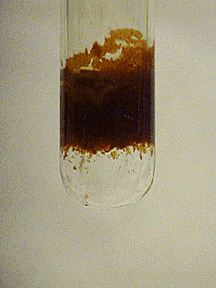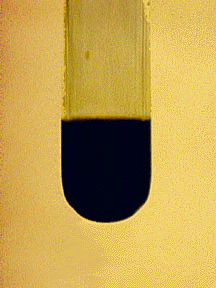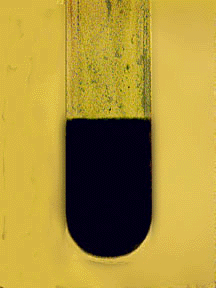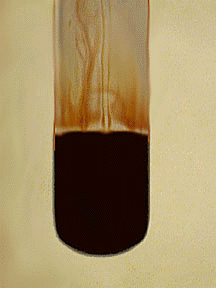
Iron, Fe3+
Most common oxidation states: +2, +3
M.P. 1535o
B.P. 2750o
Density 7.87 g/cm3
Characteristics: Gray, moderately active metal.
Characteristic reactions of Fe2+ and Fe3+:
The [Fe(H2O)6]3+ ion is colorless (or pale pink), but many solutions containing this ion are yellow or amber-colored because of hydrolysis. Iron in both oxidation states forms many complex ions.
Aqueous Ammonia:
Aqueous ammonia reacts with Fe(II) ions to produce white gelatinous Fe(OH)2, which oxidizes to form red-brown Fe(OH)3:

Aqueous ammonia reacts with Fe(III) ions to produce red-brown Fe(OH)3:

Both precipitates are insoluble in excess aqueous ammonia. Iron(II) hydroxide quickly oxidizes to Fe(OH)3 in the presence of air or other oxidizing agents.
Sodium Hydroxide:
Sodium hydroxide also produces Fe(OH)2 and Fe(OH)3 from the corresponding oxidation states of iron in aqueous solution.


Neither hydroxide precipitate dissolves in excess sodium hydroxide.
Potassium Ferrocyanide:
Potassium ferrocyanide will react with Fe3+ solution to produce a dark blue precipitate called Prussian blue:

With Fe2+ solution, a white precipitate will be formed that will be converted to blue due to the oxidation by oxygen in air:

Note: Many metal ions form ferrocyanide precipitates, so potassium ferrocyanide is not a good reagent for separating metal ions. It is used more commonly as a confirmatory test.
Potassium Ferricyanide:
Potassium ferricyanide will give a brown coloration but no precipitate with Fe3+. With Fe2+, a dark blue precipitate is formed. Although this precipitate is known as Turnbull's blue, it is identical with Prussian blue.

Potassium Thiocyanate:
KSCN will give a deep red coloration to solutions containing Fe3+:

No Reaction:
Cl-, SO42-